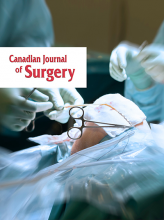Nearly 2 years has elapsed since the landmark study and report by the Safe Surgery Saves Lives Study Group about reduction of morbidity and mortality in a global population through the use of a surgical safety checklist.1 In Canada, recommendations to adopt the checklist have been endorsed by the Canadian Patient Safety Institute, several national specialty societies and provincial councils on patient safety and quality. Implementation of a checklist is now an accreditation standard for Canadian hospitals. By now, sufficient time has elapsed for wide implementation. A quick tour of hospital operating rooms (ORs) throughout the country confirms that posters identifying a multiphase checklist have been adopted into the culture of the OR.
A key question persists as to whether adoption has fully penetrated the practice of OR teams and whether it has yielded a positive impact on patient safety at the local level. Not infrequently, surgeons report that the checklist is merely an administrative exercise to meet accreditation standards. An exasperated perioperative director in my hospital recently reported that the checklist is being done in an inadequate manner, especially when it comes to equipment and implants. Are these simply the complaints of a reluctant minority and matters to be addressed in an otherwise solid adoption of the checklist tool? What does the future hold, and how should surgeons support full compliance with the checklist as a solid confirmation of support for patient safety?
There are several observations that suggest care is optimized with checklist adoption. First, personal communication with surgeons from 3 of the index study hospitals in Toronto, Ont., Seattle, Wash., and Auckland, New Zealand, indicate that they have harnessed the initial checklist to redouble their efforts to further improve quality of the preoperative briefing and time-out processes and to enhance accurate postoperative sponge and instrument counts. The 3-phase checklist has framed an iterative process to re-address gaps in providing safe care. Second, some health jurisdictions have improved upon the original checklist by adapting it to become briefer, particularly targeting procedures that are less intense and directed toward healthier surgical populations. Third, those surgeons who work by a principle of “enlightened self-interest” find that the use of checklists improves on-time starts and turnaround times in the OR, thus reducing the inconvenience of delays and cancellations of their patients’ surgeries. Finally, some surgeons find that the checklist improves their ability to assert strong leadership with the OR team.
It is prudent for surgeons to review their compliance with checklists in the context of a growing mandate to pro-vide a patient-centred approach to safety and quality improvement. This mandate has specified a number of strategies for clinical services. The first is outcomes monitoring. From a process/compliance perspective, checklist compliance may be monitored. More importantly, end-result monitoring is forthcoming to track such events as surgical site infections, postoperative pneumonia and thromboembolism. An example of this is the American College of Surgeons’ National Surgical Quality Improvement Project (NSQIP), which has in recent years been adopted in 2 British Columbia hospitals and soon will roll out to other sites throughout that province. An important aspect of NSQIP is the ability to adjust the data according to patient risks. A second major strategy is that of ongoing surveillance. Typically, case series audits have fulfilled this role, and some have been suitable for publication in this journal. However, novel safety reporting systems are focusing on structured data collection and risk adjustment such as the Patient Safety and Learning System. This web-based reporting tool is being implemented across British Columbia. Third, patient- or event-specific reviews continue to work well at divisional practice levels. A typical example is the regularly scheduled morbidity and mortality round, which involves trainees and surgical faculty. Although these are retrospective reviews, they can formulate the basis for system- or practitioner-based improvements in care. Other examples include hospital critical incident reviews, and patients’ complaints may also be investigated through patient quality review boards that interface with the public’s concerns. Finally, the checklist formulates a typical example of a cultural tool that can be harnessed by surgeons to improve outcomes among other examples such as safety huddles, walk-arounds and regional surgery executive councils that introduce standardized ways to improve processes of care across the continuum of hospitals and communities. All of these measures to improve quality and safety are introducing new criteria with which surgeons must remain literate, and completion of the checklist will help maintain high-quality reports on public dashboards.
Inevitably, surgery has become more complex in a world with advanced communication systems, more sophisticated technology and patients with more diverse and complex comorbidities. Multiple-team surgeries from diverse specialties are more common. Further, most Canadian ORs have more layers of personnel who are seeking training as medical and nursing schools distribute and expand their education programs. These changes open up the spectrum for more errors to occur. Dr. Atul Gawande, a Professor of Surgery at Harvard Medical School, argues that using checklists can help surgeons to cope with increasing complexity.2 Use of a rigorous checklist in this rapidly changing environment will consolidate surgeons’ aims to enhance both patient safety and clinical professionalism.
Footnotes
Competing interests: None declared.









